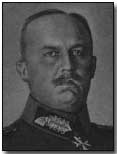Primary Documents - Erich Ludendorff on the Second Battle of the Marne, 1919
 The
Second Battle of the Marne -
which ran from 15 July to 4 August 1918 - was intended as Germany's final
major attempt at breakthrough on the Western Front prior to the arrival of
ever-increasing U.S. troops on the battlefield.
The
Second Battle of the Marne -
which ran from 15 July to 4 August 1918 - was intended as Germany's final
major attempt at breakthrough on the Western Front prior to the arrival of
ever-increasing U.S. troops on the battlefield.
In the event the battle proved a significant Allied victory. Once it became clear that the Germans had not only failed in their aim to win the war in the offensive, but had in fact lost ground, a number of German commanders, including Crown Prince Wilhelm, believed the war was lost.
Reproduced below are chief German strategist Erich Ludendorff's views of the Allied counterattacks at the Marne as viewed by him in the war's aftermath, in 1919; these unsurprisingly contrasted with his earlier official stance published on 4 August 1918 (click here).
Click here to read General Gouraud's appeal to his forces at the onset of the battle. Click here to read an extract from U.S. Commander-in-Chief John J Pershing's official report summarising U.S. participation in the battle. Click here to read a German memoir focusing on the events of 15 July. Click here to read Pershing's Special Order of the Day, dated 27 August, in which he praised the role played by his forces. Click here and here to read semi-official German press statements published in July and August 1918 on the outcome of fighting at the Marne. Click here to read the official address given by French General Charles Mangin on 7 August 1915, directed to U.S. First and Second servicemen who, assisting Mangin's French Tenth Army, participated in the Allied counter-attacks launched on 18 August. Click here to read the view later given by Mangin concerning the turning point of the Allied counterattack at the Marne. Click here to read the official address given by French Sixth Army General Jean Degoutte to French and U.S. troops towards the close of the battle, on 9 August 1918, in which he praised the conduct of American forces. Click here to read an account by Karl Rosner of how news of the battle was received by the Kaiser.
Erich Ludendorff on the Second Battle of the Marne, 1919
On July 18th the enemy attacked after a short, sharp artillery preparation and under shelter of a screen of smoke. He employed masses of infantry and a greater force of tanks than had ever before been concentrated in one drive. The tanks, however, were unimportant except as they were used to carry men through our lines. These men then attacked us from the rear or formed machine-gun nests which were very effective.
South of Soissons our infantry did not resist this attack as firmly as I had hoped, although we had a division in line there which had been considered particularly reliable.
A gap was made in our line, and this soon widened. This situation north of the Ourcq River made it necessary to withdraw our troops further south. The success of the enemy came to me as a shock, and I sent immediate reinforcements, which, however, owing to the difficulties of transport, were slow in arriving.
On July 19th our situation was much more satisfactory. Even the troops who had been surprised on the preceding day now rallied and fought well. The reason they gave for their former failure was the wholly unexpected nature of the attack. One General of a division told me he had personally visited our foremost line on July 17th, and there had been not the slightest sign of the enemy's activity.
Source: Source Records of the Great War, Vol. VI, ed. Charles F. Horne, National Alumni 1923
Around one million Indian troops served in WW1, of which some 100,000 were either killed or wounded.
- Did you know?
